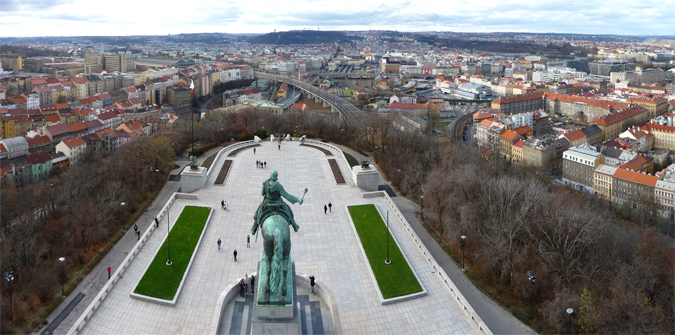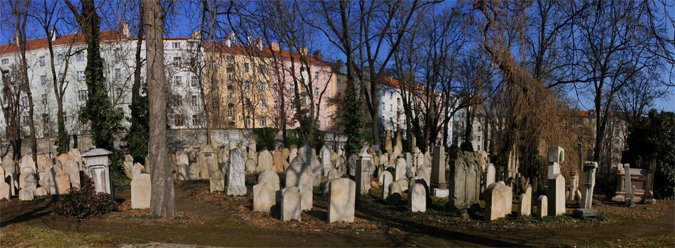Introduction
The Prague neighborhood series has been running on Expats.cz for almost a year, but we’re only covering Žižkov now. However, this doesn’t mean that the neighborhood is any less significant. Indeed, it’s one of Prague’s most well-known districts and familiar to expats, a fair number of whom live there.
Žižkov is well-known for a variety of reasons, especially because of its reputation as one of Prague’s more run-down quarters. It’s overshadowed by its neighbor Vinohrady, which is more elevated geographically and socially. Bourgeois Vinohrady is associated with the good life; Žižkov is seen as more edgy.
But Žižkov isn’t simply stereotypical “grit and grime” and wall-to-wall pubs. If you stroll through the streets along its southeastern edge, it’s difficult to trace where Vinohrady ends and Žižkov begins, thanks to the quality of the housing stock. As home to the Masopust (Carnival) and famous Akropolis Theater, Žižkov makes an important contribution to Prague’s cultural life. And in terms of services, such as shopping or eating out, Žižkov offers more and more.
Location
Žižkov proper occupies a relatively small area centered on the streets between Husitská and Seifertova. However, in terms of the land register, some neighboring streets are part of it. For example, addresses that most would classify as Vinohrady, are in Žižkov. The neighborhood is located immediately east of the city center and stretches from the main railway station to the vast Olšany cemeteries (Olšanské hřbitovy). To the north, Žižkov is neatly separated from Karlín by the natural barrier of Vítkov Hill. To the south lies Vinohrady.
Husitská, starting at the Wilsonova and continuing east before it becomes Koněvova, is one of the main thoroughfares. Other main streets include Seifertova, which runs roughly east-west, and Vinohradská, which skirts the southern edge of Prague 3.

View from Vítkov Hill – Žižkov on the left hand side
History
As its name suggests, Žižkov is of significance in Czech history. It takes its name from Hussite warrior Jan Žižka, whose equestrian statue, on the edge of Vítkov Hill, looms menacingly over Žižkov and Karlín. Today, it’s hard to imagine that an important battle took place at this site in 1420, when Žižka’s peasant army defeated the forces of Holy Roman Emperor Sigismund.
Otherwise, the Žižkov story, like that of the other 19th century inner districts of Prague, is mainly about the transition from rural peace to urban bustle. It was once covered in vineyards, which were established through a decree of Emperor Charles IV. A number of small settlements connected with the vineyards sprang up, and while they no longer exist today, their names, such as Ohrada and Pražačka, remain on maps.
In the 17th and 18th centuries, neighboring Prague suffered a number of plague outbreaks, prompting an urgent search for burial grounds beyond the city walls. Žižkov was chosen, leading to the establishment of the enormous Olšany cemeteries, Prague’s largest.
Meanwhile, Prague was beginning to grow and breached its walls in the mid-19th century. Žižkov’s proximity to Prague and the coming of the railways helped turn the area into an urban center.
By the early 20th century, Žižkov had become a dense quarter close to the center of Prague, although it didn’t become part of the capital until 1922, which isn’t surprising given the strong pride of local residents in their separate identity. Such a reputation is also reflected in the local politics. The Communist Party received strong support in the working-class neighborhood known as “Red Žižkov”.
Despite its support for Communism, Žižkov languished during the Communist period and remained one of Prague’s poorer areas; the large Roma population in the area fared even worse. Little changed in the area in the decades before 1989, apart from the construction of Prague’s tallest building, the futuristic TV Tower, designed to jam West German TV signals.
The last two decades have revived Žižkov in many ways, and led to a re-evaluation of what the district has to offer, such as accessibility and green spaces. Property prices have risen in the district, which is shaking off its bad image. Issues remain, such as the problems faced by the local Roma population, but life has generally improved in Žižkov since 1989.

Jewish cemetery in Žižkov
Getting there and around
Žižkov is one of Prague’s most accessible places to live and a very convenient destination for commuters. Much of the neighborhood is within walking distance of the city center or Vinohrady. Žižkov can also be reached be approached on foot from Karlín via the pedestrian tunnel under Vítkov Hill. Commuting by tram from should take around 10 minutes or less.
In terms of public transport, trams and buses are the most convenient means of reaching Žižkov. Currently, tram numbers 5, 9 and 26 go through the area, running east-west along the arterial route of Seifertova before going off in different directions. The number 9, a key route in the capital, runs very frequently. Night tram numbers 55 and 58 also ply Seifertova.
Line A of the metro runs along the southern edge of Prague, and Želivského, Flora, and Jířího z Poděbrad stations are within easy reach of the heart of Žižkov. The last two stations connect with several tram routes, as well as bus routes.
Buses (including night bus number 509) in Žižkov are limited to a few services along the Husitská/Koněvova artery.
Environment
Prague 3, and particularly Žižkov, has always suffered from poor air quality, and the location of neighborhood, wedged between the Vinohrady ridge and Vítkov Hill, merely compounds the problem. In recent years, the pollution issue has become less serious, but residents of Žižkov still complain about poor atmospheric quality, which is compounded by smoggy conditions that affect Prague in the fall and winter.
Other problems include those common to other Prague neighborhoods such as noise and traffic fumes along busy roads, dog fouling, and scruffy spaces made more unattractive by graffiti.
Green space
Žižkov is a surprisingly green district and can boast some extensive stretches of open space and some the best panoramas of downtown Prague.
The largest expanse is the long, finger-shaped Vítkov Hill a steep, densely wooded ridge. The western tip affords brilliant views across to the Castle and city center and forms a superb location for the Jan Žižka monument. Runners and Sunday afternoon strollers frequent the long straight road that ends at the National Monument (Památník národního osvobození).
The other main open space, Parukářka, is another sought-after spot, a vantage point with superb views to the Castle and Vinohrady. Naturally, in the summer the open spaces of the park attract sunbathers and frisbee players, among others. The beer garden on the summit, overlooking Prokopova Street is also a perennial summer draw.
While technically not in Žižkov, Riegrovy sady, one of the expat haunts in the Czech capital, is very close and a short, if steep, walk from the streets leading off Seifertova.
Housing
Like Karlín, Žižkov is essentially a tenement district, with the occasional infill paneláky scattered around. If you’re looking for a villa or any other form of housing, you’re best looking elsewhere.
Most apartments date from the 19th or early 20th century, and consist of tenements grouped around a central courtyard. Much of the housing stock is of good quality, despite the long-established reputation of Žižkov, and in the southeastern stretches of the neighborhood, roughly between Kubelíkova and Vinohradská Streets, there is little to distinguish the apartments, many of which were built in the 1920s and 30s, from their Vinohrady counterparts.
As Žižkov is an established area and densely built up, there is little in the way of newly-built projects for property seekers, although the upscale, newly-completed Central Park development, on the eastern edge of Žižkov, was built on a cleared site, and there are plans for redeveloping the Žižkov Freight Station (Nákladové nádraží Žižkov).
SUMMARY
Strengths
• Access to city center
• Access to open spaces
• Good quality housing
Weaknesses
• Pollution
• Lack of off-street parking
• Limited range of housing types
Part II of this article looks at other aspects of life in Žižkov including shopping and culture.
***
OTHER PRAGUE DISTRICTS:












 Reading time: 7 minutes
Reading time: 7 minutes 

























